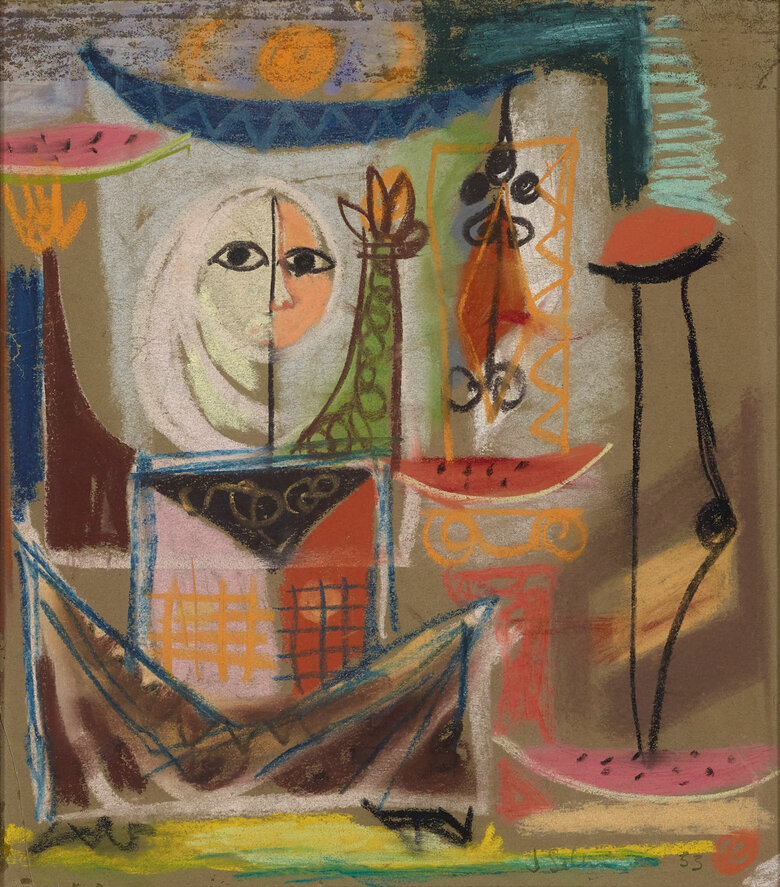Good and Evil, an abstraction from the 1950s by the father of modern Iraqi art, Jewad Selim, is a 50x75 cm oil on canvas painting that was a study for a commissioned tile mural, which was planned for the entrance of the Iraqi Red Crescent Society Headquarters in Baghdad, Iraq.[1]Unfortunately the project was never materialized for Jewad Selim died before he was able to execute the mural. The painting depicts various mythic Mesopotamian figures and seven distinct crescent-like shapes in a minimalist and simplistic style.[2]. Selim utilizes muted blue, green, and red tints that exacerbate the dulled effect of the white-grayish space within which these shapes are organized. His prioritization of line and shape over color allows the background to function as a stage.[3]where patterns, such as the crescent moon, oscillate through their alternating color and nonconformity. The mythological forms and figures lack volume and are constructed only in their reduced geometric shapes and lines, highlighting the painting's fabular quality.[4]. The repetition of these visual patterns demands the viewer to make connections between the various shapes despite their disparity.
The painting reflects Selim's theoretical and philosophical outlook regarding the elements that must be drawn upon to cultivate a unique Iraqi modern art: an understanding of European art traditions and incorporating Iraqi heritage. This is clear in terms of the references throughout the piece: on the left side of the painting, there is a simplistic rendition of Pazuzu, the horned Assyrian/Babylonian demon from the underworld with his bulging eyes, flared snout, and a snake tail.[5]. On the right side of the painting is a human figure safe within the confines of the house, his eye drawn in the manner of Sumerian artwork, while outside, he is surrounded by mythical creatures engaged in conflict. The crescent moon motif was plucked from its symmetrical aestheticism within Islamic decorative art and scattered across the canvas, guiding the viewer’s eyes through its trajectory. Selim heightens the expressiveness of the symbols he uses by simplifying both colors and shapes and accentuating the dramatic relationship between them.[6].
The early 1950s were especially significant in Selim’s growth towards becoming a leading instigator of modern Iraqi art. He had just returned from London, where he had trained at the Slade School of London (1946-1951),bringing with him the various influences of artists and art movements of Western Europe. However, he had also spent this time reacquainting himself with the works of Babylonian, Akkadian, and Assyrian artifacts through his work at the Iraqi Museum of Antiquities, as well as sampling from the recurrent shapes and motifs prevalent in Islamic art[7]. These threads of his life helped shape the core beliefs of Selim’s foundational national art movement, the Baghdad Group of Modern Art, which he co-founded with Shakir Hassan Al Said in 1949[8]. The purpose of the movement was to “[create] a unique personality for our civilization … [by drawing upon] the heritage of the present times and our awareness of local character.”[9]
The vision was to create distinct and authentic Iraqi art that is premised upon istilham al-turath, whereby inspiration is drawn from a tradition that spans thousands of years of pre-Islamic Mesopotamian civilization up to, and including, the then newly rediscovered pictorial arts of the 13thcentury Abbasid Caliphate[10], notably the illustrations by Yahya bin Mahmud al-Wasiti[11]. Selim wanted to establish a contemporary national modernist art movement that is rooted in local tradition by reclaiming Iraq's lost legacy while also participating in dialogue with international modernism[12]. In that quest, Selim managed to fuse together the abstractions of Western techniques with the abstractions of his heritage, as is reflected in this painting’s sources of inspiration.[13].
Sources:

-Front.jpg)
-Front.jpg)



